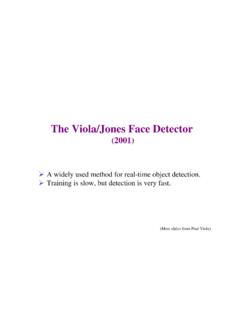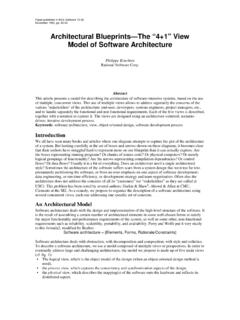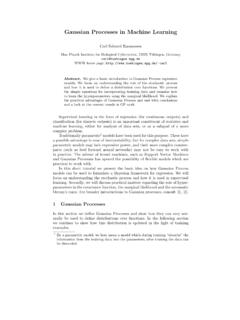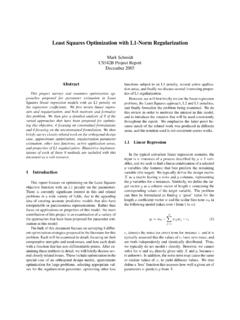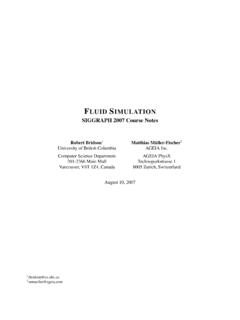Transcription of Solving Constraint Satisfaction Problems (CSPs) using Search
1 Solving Constraint Satisfaction Problems (CSPs) using Search Alan Mackworth UBC CS 322 CSP 2 January 28, 2013 Textbook Lecture Overview Constraint Satisfaction Problems (CSPs): Definition and Recap CSPs: Motivation Solving CSPs - Generate & Test - Graph Search 2 3 Course Overview Environment Problem Type Logic Planning Deterministic Stochastic Constraint Satisfaction Search Arc Consistency Search Search Logics STRIPS Variables + Constraints Variable Elimination Bayesian Networks Decision Networks Markov Processes Static Sequential Representation Reasoning Technique Uncertainty Decision Theory Course Module Variable Elimination Value Iteration Planning Now focus on CSPs Standard Search vs.
2 CSP First studied general state space Search in isolation Standard Search problem: Search in a state space State is a black box - any arbitrary data structure that supports three problem-specific routines: goal test: goal(state) finding successor nodes: neighbors(state) if applicable, heuristic evaluation function: h(state) We ll see more specialized versions of Search for various Problems 4 Constraint Satisfaction Problems : State Successor function Goal test Solution Heuristic function Planning : State Successor function Goal test Solution Heuristic function Inference State Successor function Goal test Solution Heuristic function Search in Specific R&R Systems Constraint Satisfaction Problems (CSPs): Definition 6 Definition: A Constraint Satisfaction problem (CSP) consists of: a set of variables V a domain dom(V) for each variable V V a set of constraints C Another example: V = {V1,V2} dom(V1) = {1,2,3} dom(V2) = {1,2} C = {C1,C2,C3} C1: V2 2 C2: V1 + V2 < 5 C3: V1 > V2 Simple example: V = {V1} dom(V1) = {1,2,3,4} C = {C1,C2} C1: V1 2 C2: V1 > 1 Constraint Satisfaction Problems (CSPs).
3 Definition 7 Definition: A model of a CSP is an assignment of values to all of its variables that satisfies all of its constraints. Simple example: V = {V1} dom(V1) = {1,2,3,4} C = {C1,C2} C1: V1 2 C2: V1 > 1 All models for this CSP: {V1 = 3} {V1 = 4} Definition: A Constraint Satisfaction problem (CSP) consists of: a set of variables V a domain dom(V) for each variable V V a set of constraints C Constraint Satisfaction Problems (CSPs): Definition 8 Definition: A model of a CSP is an assignment of values to all of its variables that satisfies all of its constraints. Which are models for this CSP? Another example: V = {V1,V2} dom(V1) = {1,2,3} dom(V2) = {1,2} C = {C1,C2,C3} C1: V2 2 C2: V1 + V2 < 5 C3: V1 > V2 {V1=3, V2=2} {V1=1, V2=1} {V1=3, V2=1} {V1=2, V2=1} Definition: A Constraint Satisfaction problem (CSP) consists of: a set of variables V a domain dom(V) for each variable V V a set of constraints C Possible Worlds a model is a possible world that satisfies all constraints 9 Definition: A possible world of a CSP is an assignment of values to all of its variables.
4 Definition: A model of a CSP is an assignment of values to all of its variables that satisfies all of its constraints. Another example: V = {V1,V2} dom(V1) = {1,2,3} dom(V2) = {1,2} C = {C1,C2,C3} C1: V2 2 C2: V1 + V2 < 5 C3: V1 > V2 Possible worlds for this CSP: {V1=1, V2=1} {V1=1, V2=2} {V1=2, V2=1} (a model) {V1=2, V2=2} {V1=3, V2=1} (a model) {V1=3, V2=2} Constraints Constraints are restrictions on the values that one or more variables can take Unary Constraint : restriction involving a single variable : V2 2 k-ary Constraint : restriction involving k different variables binary (k=2): V1 + V2 < 5 3-ary.
5 V1 + V2 + V4 < 5 We will mostly deal with binary constraints Constraints can be specified by 1. listing all combinations of valid domain values for the variables participating in the Constraint for Constraint V1 > V2 and dom(V1) = {1,2,3} and dom(V2) = {1,2}: 2. giving a function (predicate) that returns true if given values for each variable which satisfy the Constraint else false: V1 > V2 10 V1 V2 2 1 3 1 3 2 Constraints Constraints can be specified by 1. listing all combinations of valid domain values for the variables participating in the Constraint for Constraint V1 > V2 and dom(V1) = {1,2,3} and dom(V2) = {1,2}: 2. giving a function that returns true when given values for each variable which satisfy the Constraint : V1 > V2 A possible world satisfies a set of constraints if the values for the variables involved in each Constraint are consistent with that Constraint 1.
6 They are elements of the list of valid domain values 2. Function returns true for those values Examples {V1=1, V2=1} (does not satisfy above Constraint ) {V1=3, V2=1} (satisfies above Constraint ) 11 V1 V2 2 1 3 1 3 2 Scope of a Constraint 12 Examples: V2 2 has scope {V2} V1 > V2 has scope {V1,V2} V1 + V2 + V4 < 5 has scope {V1,V2,V4} How many variables are in the scope of a k-ary Constraint ? k variables Definition: The scope of a Constraint is the set of variables that are involved in the Constraint Finite Constraint Satisfaction Problem: Definition 13 Definition: A finite Constraint Satisfaction problem (FCSP) is a CSP with a finite set of variables and a finite domain for each variable.
7 We will only study finite CSPs here but many of the techniques carry over to countably infinite and continuous domains. We use CSP here to refer to FCSP. The scope of each Constraint is automatically finite since it is a subset of the finite set of variables. Examples: variables, domains, constraints Crossword Puzzle: variables are words that have to be filled in domains are English words of correct length (binary) constraints: words have the same letters at cells where they intersect Crossword 2: variables are cells (individual squares) domains are letters of the alphabet k-ary constraints: sequences of letters form valid English words (k= 2,3,4,5,6,7,8,9) 14 Examples: variables, domains, constraints sudoku variables are cells domain of each variable is {1,2,3,4,5,6,7,8,9} constraints: rows, columns, boxes contain all different numbers How many possible worlds are there?
8 (say, 53 empty cells) How many models are there in a typical sudoku ? 15 53*9 953 539 About 253 953 1 Examples: variables, domains, constraints Scheduling Problem: variables are different tasks that need to be scheduled ( , course in a university; job in a machine shop) domains are the different combinations of times and locations for each task ( , time/room for course; time/machine for job) constraints: tasks can't be scheduled in the same location at the same time; certain tasks can't be scheduled in different locations at the same time; some tasks must come earlier than others; etc. n-Queens problem variable: location of a queen on a chess board there are n of them in total, hence the name domains: grid coordinates constraints: no queen can attack another 16 Constraint Satisfaction Problems : Variants We may want to solve the following Problems with a CSP.
9 Determine whether or not a model exists find a model find all of the models count the number of models find the best model, given some measure of model quality this is now an optimization problem determine whether some property of the variables holds in all models 17 Solving Constraint Satisfaction Problems Even the simplest problem of determining whether or not a model exists in a general CSP with finite domains is NP-hard There is no known algorithm with worst case polynomial runtime. We can't hope to find an algorithm that is polynomial for all CSPs. However, we can try to: find efficient (polynomial) consistency algorithms that reduce the size of the Search space identify special cases for which algorithms are efficient work on approximation algorithms that can find good solutions quickly, even though they may offer no theoretical guarantees find algorithms that are fast on typical (not worst case) cases 18 Lecture Overview Constraint Satisfaction Problems (CSPs): Definition and Recap Constraint Satisfaction Problems (CSPs): Motivation Solving Constraint Satisfaction Problems (CSPs) - Generate & Test - Graph Search 19 CSP/logic.
10 Formal verification Hardware verification Software verification ( , IBM) (small to medium programs) Most progress in the last 10 years based on: Encodings into propositional satisfiability (SAT) 20 The Propositional Satisfiability Problem (SAT) Formula in propositional logic it only contains propositional (Boolean) variables Shorthand notation: x for X=true, and x for X=false Literal: x, x In so-called conjunctive normal form (CNF) Conjunction of clauses (disjunctions of literals) , F = (x1 x2 x3) ( x1 x2 x3) ( x1 x2 x3) Let s write F as a CSP: 3 variables: X1, X2, X3 Domains: for all variables {true, false} Constraints (clauses): (x1 x2 x3) ( x1 x2 x3) ( x1 x2 x3) One of the models: X1 = true, X2 = false, X3 = true 21 Importance of SAT Similar Problems as in CSPs Decide whether F has a model Find a model of F First problem shown to be NP-hard problem (3-SAT) One of the most important Problems in theoretical computer science Is there an efficient ( worst-case polynomial) algorithm for SAT?

